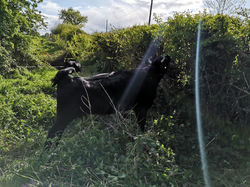500 years of history in Ireland
 |  |  |
|---|---|---|
 |  |  |
 |  |
Hedgerows
When Brackloon Castle was first built about the early 1500s the Irish landscape was vastly different to that we see today. From the rooftop, the occupants could survey a landscape of wide open grassland with some cornfields between large areas of heather, gorse and bracken-covered raised bog, tangled overgrowth and dense forest. The pattern of fields enclosed by earthen banks, thick hedges and stone walls we see today only became widespread from the early eighteenth century.
In the intervening time our great forests were cut down, the bogs cut back and the overgrowth tamed. Now our native wildlife that once abounded in that older landscape make their home in the smaller tree clumps and native hedgerows. Three quarters of Ireland’s species of flowering plants and nearly two thirds of Ireland's bird species can be found in hedgerows.
The fields of our farm are dispersed across various locations within our parish and our native hedgerows and field boundaries reflect that diversity.
The combination of hawthorn, blackthorn, hazel, ash and brambles is a pattern repeated throughout many of the fields and is typical of this eastern area of County Galway.
Around the castle and along the mossy banks of the old coach road that runs behind, this is the predominant material alongside climbing ivy. An occasional oak tree and the almost forgotten local place-name of ‘Derrybane’ (pronounced ‘derry-bawn’) or ‘white oak wood’ suggests a now-lost medieval oak wood in the vicinity of the castle. To the east, after the winter floods recede, summer hay is cut on low-lying riverside meadow or callows at the bottom of a sloping sandy esker hill. Here, in the wetter parts, willow or sally appears alongside hazel and ash. In between are flat fields of grassland with varying degrees of black boggier soils and others on the margin of the esker with sticky-blue clay.
Old elder trees add colour and aroma to the summer hedgerows around the fields in Killaltanagh and Kilmacshane between the castle and the Shannon. Their musty cream blossoms are ready for picking usually in early July for elderflower cordial. Here these hedges are supplemented with holly. As these fields approach the raised peat bogs of Killnaborris or Clonfert, their damper margins begin to include more willow, fern and ‘flaggers’ and on the edge of the bog, the prickly thorns of gorse (or furze as its locally known) with its yellow blaze of flower in summer.
These native Irish hedgerows provide food and shelter for bees, insects and animals and birds large and small. When not with heads down grazing in the fields, our Kerry cattle love nothing better than to forage in the field margins and hedgerows. In summer, they shelter from the sun in the hedge’s shade or can be seen stretching their necks deep into the abundance of new leaves or scratching against the low-lying hazel branches.
Here at Brackloon we are happy to preserve our native hedgerows as a valuable element of our cultural and natural landscape.